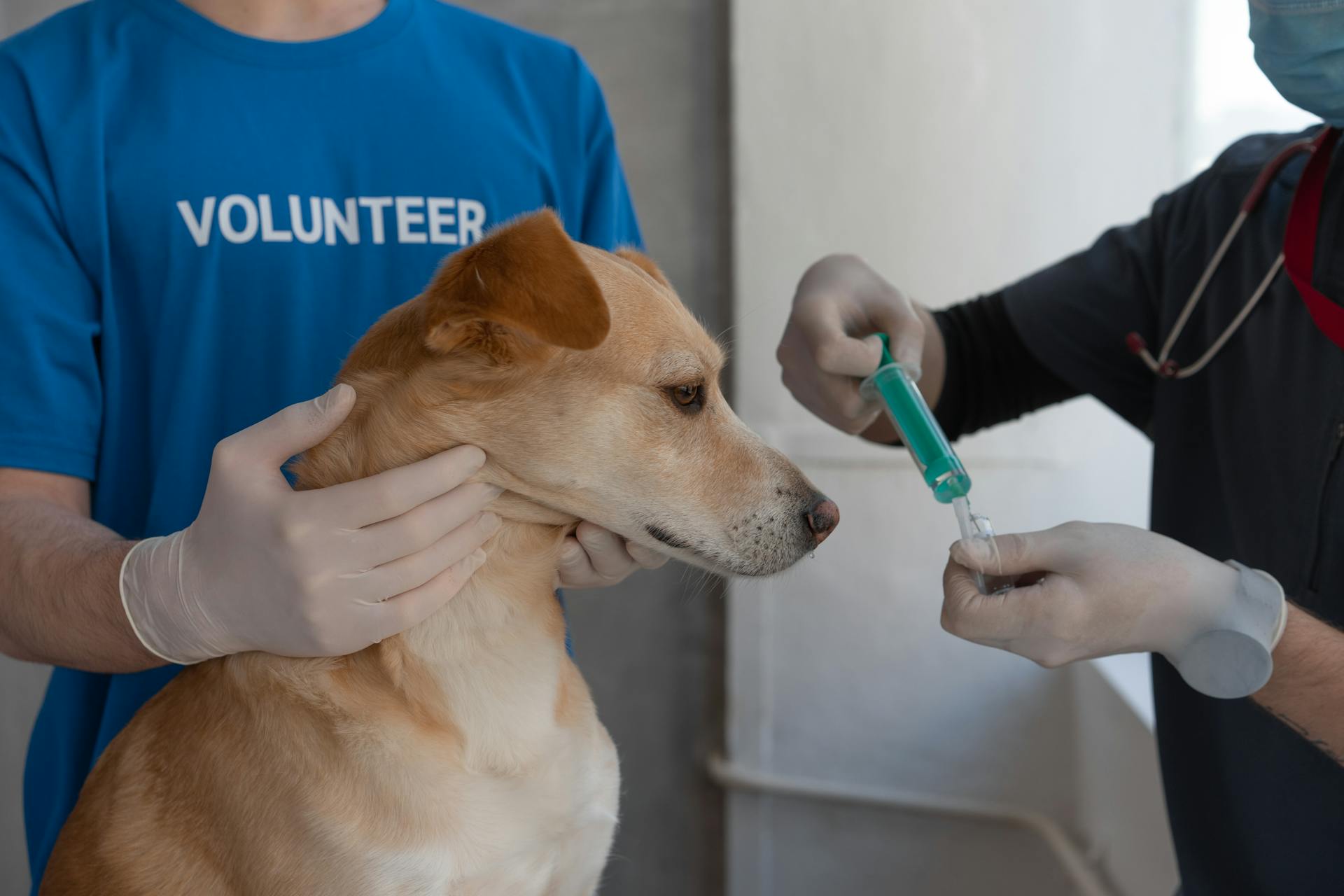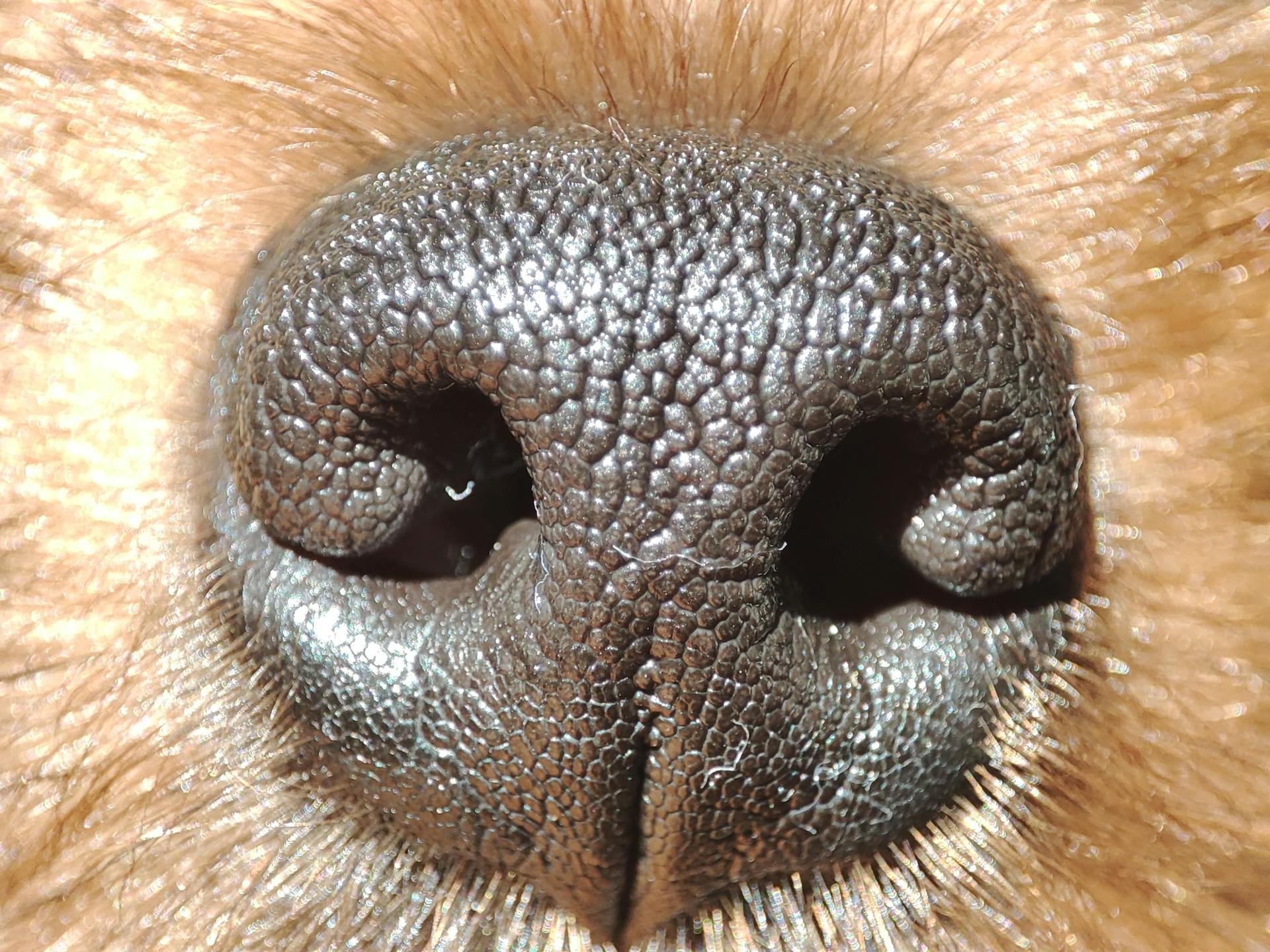
Allergies in dogs can be a real challenge for pet owners. Canine allergies can last anywhere from a few months to several years, depending on the severity of the allergy and the effectiveness of treatment.
Some dogs may experience mild reactions to allergens, which can be managed with simple changes to their diet and environment. However, more severe allergies can require ongoing medication and veterinary care.
In some cases, allergies can be seasonal, with symptoms worsening during specific times of the year. For example, dogs with environmental allergies may experience worse symptoms during peak pollen seasons.
What Are Allergies?
Allergies in dogs are a common issue that can cause a range of symptoms. An allergy occurs when a dog's immune system overreacts to substances that are usually harmless. These substances, known as allergens, can trigger an allergic response when inhaled, ingested, or come into contact with the dog's skin. The dog's body mistakenly identifies these normal environmental substances as threats. This can lead to a variety of physical symptoms. The severity of these reactions can vary greatly, ranging from mild discomfort to severe, life-threatening conditions.
Symptoms and Diagnosis
Symptoms of dog allergies can be quite varied and may include itchy skin, skin rashes, and hives. Dogs with allergies often exhibit chronic ear infections, runny nose, and watery eyes. These symptoms can be a response to inhaled allergens like pollen or dust.
A runny nose and watery eyes are common in dogs with allergies, similar to humans. Sneezing can also be a sign of airborne allergies in dogs. This can be more pronounced in certain environments or seasons when specific allergens are present.
If you notice any of these symptoms in your dog, it's essential to consult with a veterinarian. They can conduct tests to determine the cause of the allergies and recommend appropriate treatment to relieve your dog's discomfort.
Some common symptoms of dog allergies include:
- Itchy skin (pruritus)
- Skin rashes and hives
- Chronic ear infections
- Runny nose and watery eyes
- Sneezing
- Paw chewing/licking
- Digestive issues
- Hair loss and bald patches
- Hot spots
- Breathing difficulties
- Behavioral changes
Diagnosing dog allergies usually involves a comprehensive evaluation by a veterinarian, including a review of the dog's medical history, physical examination, and specific allergy tests.
What Are the Symptoms?

Itchy skin is one of the most noticeable signs of allergies in dogs, often concentrated around the face, feet, and ears.
Dogs with allergies might experience skin rashes and hives, particularly after exposure to a potential allergen. Red, inflamed patches on the skin or raised welts known as hives can be a clear indication of an allergic reaction.
Chronic ear infections are another common symptom of allergies in dogs, often accompanied by head shaking, ear scratching, redness inside the ear, and an unusual odor or discharge.
Dogs with allergies might have a runny nose and watery eyes, similar to humans experiencing allergies. This is a clear response to inhaled allergens like pollen or dust.
Paw chewing and licking can be a sign of allergies in dogs, often due to itchiness and leading to discoloration of the fur on their paws from excessive licking.
Here are some common symptoms of allergies in dogs:
- Itchy skin (pruritus)
- Skin rashes and hives
- Chronic ear infections
- Runny nose and watery eyes
- Paw chewing and licking
- Digestive issues (vomiting, diarrhea, or gas)
- Hair loss and bald patches
- Hot spots
- Breathing difficulties
- Behavioral changes (restlessness, agitation, or decreased activity levels)
Diagnosing
Diagnosing dog allergies can be a complex process, but it's essential to identify the root cause of your dog's symptoms. A veterinarian will typically conduct a comprehensive evaluation, including a review of your dog's medical history and a physical examination.

To determine the best course of action, your veterinarian may recommend specific allergy tests, such as blood tests or skin prick tests. In some cases, an elimination diet may be used to identify food allergies.
The most common age range for the onset of clinical signs that led to a suspicion of food allergy is between 1 to 6 years old, affecting 56% of dogs. This is followed by 6 months to 1 year, affecting 25% of dogs.
Dog owners are often the first to suspect a potential food allergy, with 60% of owners reporting they were the first to suspect an allergy. Veterinarians are the second most common source of suspicion, with 35% of owners reporting they suspected an allergy.
Common dermatological signs of food allergies include licking and chewing their paws (72%), bilateral ear infections (48%), and diagnosed skin infections (40%).
On a similar theme: Diabetes and Dogs Symptoms
Treatment and Management
Atopic dermatitis, a common allergy in dogs, can be controlled but not cured. Symptoms can be managed with anti-inflammatory therapy, such as corticosteroids or antihistamines, which can quickly block the allergic reaction.
Shampoo therapy is also beneficial, as frequent bathing with a hypoallergenic shampoo can soothe itchy, inflamed skin. Bathing also rinses out allergens in and on the coat that can be absorbed through the skin.
Treatment options for food allergies are different, as they require identifying and eliminating the offending component(s) of the diet. This can be done with an elimination diet trial using a veterinary hypoallergenic diet, which must be fed exclusively for at least eight weeks.
Managing allergies in dogs is crucial to keeping them happy, healthy, and symptom-free. Early diagnosis and treatment can make a significant difference in a dog's quality of life.
Here are some common treatment options for seasonal/environmental allergies:
- Oral medications, such as Apoquel, Atopica, or antihistamines
- Injectable medications, such as Cytopoint
- Fatty acids
- Steroids
- Frequent bathing and other topical therapies, such as sprays, wipes, or a mousse
Immunotherapy, also known as allergy shots, can be an effective long-term approach to allergy control, with a success rate of 60-70%. This treatment aims to make the immune system less reactive to the allergy-causing substances.
Treatment
Treatment for allergies in dogs can be a complex process, but with the right approach, you can help your furry friend feel better. Treatment largely depends on the length of the specific allergy season, and may involve one or more of three therapies: anti-inflammatory therapy, shampoo therapy, or hyposensitization therapy.
Readers also liked: Lick Granuloma Treatment for Dogs

Anti-inflammatory therapy can quickly block the allergic reaction in most cases, and may involve medication such as corticosteroids or antihistamines. Fatty acid supplementation in the diet can sometimes improve the response to these medications. Newer alternatives, such as oclacitinib (Apoquel) and lokivetmab (Cytopoint), can also be effective.
Shampoo therapy can be soothing to itchy, inflamed skin, and frequent bathing with a hypoallergenic shampoo can help rinse out allergens in and on the coat. Some therapeutic shampoos contain anti-inflammatory ingredients that may further benefit your pet.
Hyposensitization therapy, also known as desensitization therapy, involves repeated dosing with small amounts of the antigen to reprogram the immune system. Success rates vary, but approximately 50-75% of treated dogs see significant improvement in their clinical signs.
If your dog has food allergies, treatment requires identifying the offending component(s) of the diet and eliminating them. The most accurate way to test for food allergies is with an elimination diet trial using a veterinary hypoallergenic diet. This trial must be done exclusively for at least eight weeks.
Here are some common treatments for seasonal/environmental allergies:
- Oral medications, such as Apoquel, Atopica, or antihistamines
- Injectable medications, such as Cytopoint
- Fatty acids
- Steroids
- Frequent bathing and other topical therapies, such as sprays, wipes, or a mousse
Immunotherapy, or allergy shots, can also be effective in long-term management of environmental allergies, with a success rate of 60-70%. This treatment involves making the immune system less reactive to the allergy-causing substances.
Treatment for Flea
Treatment for Flea Allergies is crucial to reduce symptoms of itchy skin and irritation. To eliminate allergy symptoms in a flea-allergic dog, strict flea control is required.
Flea control products and medications are many and varied. Topical products like Advantage, Revolution, or Vectra come in the form of a liquid that you squeeze onto your dog’s skin. Oral preventions like Simparica, NexGard, or Comfortis are also effective, but use caution as some have flavorings your dog might be allergic to.
In severe cases, a dog’s environment must be treated for fleas. Vacuum thoroughly to remove eggs, larvae, and pupae, and discard the vacuum bag.
Take a look at this: How Long Does a Flea Live on a Dog
Types and Causes
Environmental allergies in dogs are triggered by allergens found in their surroundings, such as pollen, mold, dust mites, and grass. These allergens can cause seasonal symptoms, but indoor allergens can also cause year-round issues.
Food allergies in dogs are less common but can cause severe reactions, with common triggers including proteins like beef, chicken, dairy, or wheat. Symptoms can range from gastrointestinal issues to skin problems.
Suggestion: Does Chicken Fat Cause Allergies in Dogs
Flea allergy dermatitis is one of the most common dog allergies, caused by a reaction to flea saliva. Even a single flea bite can trigger an intense allergic reaction, leading to severe itching, skin inflammation, and secondary skin infections.
Here are the main types of dog allergies:
- Environmental Allergies: Pollen, mold, dust mites, and grass
- Food Allergies: Proteins like beef, chicken, dairy, or wheat
- Flea Allergy Dermatitis: Flea saliva
- Skin Allergies (Atopic Dermatitis): Environmental allergens
- Contact Allergies: Substances like fabrics, plastics, or cleaning products
What Are Allergies?
Allergies occur when a dog's immune system overreacts to substances that are usually harmless.
These substances, known as allergens, can trigger an allergic response when inhaled, ingested, or come into contact with the dog's skin.
The severity of allergic reactions can vary greatly, ranging from mild discomfort to severe, life-threatening conditions.
Readers also liked: Dog Hives Allergic Reaction Staffy Skin Bumps
What Are the Types of?
There are several types of allergies that can affect dogs. Environmental allergies are triggered by allergens found in a dog's surroundings, such as pollen, mold, dust mites, and grass.
Dogs with environmental allergies often suffer from seasonal symptoms, but indoor allergens can cause year-round issues. Food allergies in dogs are less common than environmental allergies but can cause severe reactions.
For your interest: Environmental Allergies in Dogs

Flea allergy dermatitis (FAD) is a common dog allergy, where a dog is allergic to flea saliva. Even a single flea bite can trigger an intense allergic reaction, leading to severe itching, skin inflammation, and secondary skin infections.
Skin allergies in dogs, also known as atopic dermatitis, result in itchy skin, leading to scratching, licking, and biting at the skin. Contact allergies occur when a dog's skin reacts to direct contact with substances like certain fabrics, plastics, or cleaning products.
Here are some common types of allergies in dogs:
- Environmental Allergies: pollen, mold, dust mites, and grass
- Food Allergies: proteins like beef, chicken, dairy, or wheat
- Flea Allergy Dermatitis (FAD): flea saliva
- Skin Allergies (Atopic Dermatitis): environmental allergens
- Contact Allergies: fabrics, plastics, or cleaning products
Types of Allergic Reactions
Allergic reactions in dogs can manifest in many ways, ranging from mild skin irritations to more severe, life-threatening conditions.
One of the most common types of allergic reactions is skin allergies, also known as atopic dermatitis. This occurs when a dog's skin reacts to environmental allergens like pollen, mold, dust mites, and grass, leading to itchy skin, scratching, licking, and biting at the skin.
Food allergies are another type of allergic reaction, which can cause severe reactions in some dogs. Common triggers include proteins like beef, chicken, dairy, or wheat, and symptoms can range from gastrointestinal issues to skin problems.
Flea allergy dermatitis (FAD) is a type of allergic reaction that occurs when a dog is allergic to flea saliva. Even a single flea bite can trigger an intense allergic reaction, leading to severe itching, skin inflammation, and secondary skin infections.
The severity of allergic reactions can vary greatly, ranging from mild discomfort to life-threatening conditions. In severe cases, an allergic reaction can cause anaphylaxis, a potentially life-threatening condition that requires immediate veterinary attention.
Here are the different types of allergic reactions in dogs:
Table 1
Let's take a closer look at Table 1, which provides some interesting insights into how dog owners suspect and diagnose canine food allergies.
The majority of dog owners (60.22%) suspect their dog's food allergy themselves, rather than relying on a veterinarian's diagnosis.

Veterinarians are often the first to suspect a food allergy, but they only account for 35.48% of the cases.
Interestingly, family members, friends, nutritionists, and groomers are rarely the ones to suspect a food allergy, with frequencies of 2.15%, 1.08%, 1.08%, and 1.08% respectively.
Here's a breakdown of the ages when dog owners first suspected a food allergy:
- Less than 6 months of age: 11.83%
- 6 months to 1 year of age: 24.73%
- 1 year to 6 years of age: 55.91%
- Older than 6 years of age: 7.53%
Let's take a look at the most common tests used to diagnose food allergies:
- Blood testing for food allergies: 37.93%
- Food elimination trial: 32.97%
- Other tests (including saliva testing and muscle strength testing): 29.50%
Note that the frequency of these tests may not add up to 100% due to rounding.
How Common Are?
Allergies in dogs are quite common and one of the frequent reasons for veterinary visits. A large number of dogs experience some kind of allergy during their lifetime.
Dogs can develop allergies to various food ingredients, but the most common ones are chicken, beef, dairy, wheat, soy, and eggs. The most common allergy is protein specific, but dogs can be allergic to more than one food ingredient.
You might like: Common Dog Diseases and Symptoms
Frequently Asked Questions
How long does it take for allergies to leave dogs system?
Recovery from a kibble allergy can take several months, but symptoms should subside once the allergen is eliminated from the diet. The process can be lengthy, but patience and persistence are key to a full recovery.
Sources
Featured Images: pexels.com


